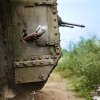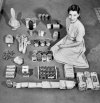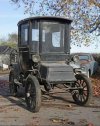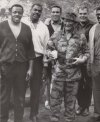You are using an out of date browser. It may not display this or other websites correctly.
You should upgrade or use an alternative browser.
You should upgrade or use an alternative browser.
Some old Photos for your enjoyment
- Thread starter JWFilips
- Start date
smokeywolf
Well-Known Member
That's only because 3 or 4 books were checked out and haven't been returned.even if it only has 6 books.
richhodg66
Well-Known Member
richhodg66
Well-Known Member
richhodg66
Well-Known Member
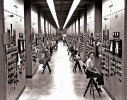
The story of the Calutron Girls is a remarkable chapter in the history of the Manhattan Project, offering a glimpse into the pivotal role played by young women in one of the most secretive and groundbreaking scientific endeavors of World War II.
Recruited mostly from high schools, these young women embarked on a journey that would take them to the heart of the war effort, to the Y-12 National Security Complex located at Oak Ridge, Tennessee. Tasked with operating calutrons, a type of mass spectrometer used to separate isotopes of uranium for the production of enriched uranium, these women became an indispensable part of the project.
Their work was shrouded in secrecy, with many of them unaware of the true nature of their tasks or the significance of the project they were contributing to. Working long hours in challenging conditions, they displayed remarkable dedication and resilience, often under the pressure of strict security protocols and the weight of the knowledge that their work could potentially alter the course of the war.
Despite the demanding nature of their roles, the Calutron Girls approached their duties with a sense of duty and patriotism, driven by a collective desire to support the war effort and bring an end to the conflict. Their contributions were instrumental in the success of the Manhattan Project, playing a crucial role in the development of the atomic bomb and ultimately helping to bring about the end of World War II.
After the war, many of these women returned to their civilian lives, their contributions largely overlooked and overshadowed by the secrecy surrounding the project. However, their legacy endures as a testament to the often unsung heroines of wartime science and the vital role played by women in advancing scientific discovery and innovation.
richhodg66
Well-Known Member
blackthorn
Active Member
Without American women Americans ----- would not exist!
Winelover
North Central Arkansas
Yeah, but auto workers were making about $.50/ hour, too.Housewife poses with a weeks’ worth of groceries in 1947. She spent a total of $12.50 a week (not including milk) to buy her groceries. On this budget, she is able to feed herself, her husband, her four-year-old twins and her cat.
View attachment 40770
Matt_G
Curmudgeon in training
They were making a lot more than that in 1947 John.Yeah, but auto workers were making about $.50/ hour, too.
Heck, they were making more than that in 1939.
Here is a link to a pdf file.
It's a wage chronology for General Motors for 1939 thru 1966.
It was put together by the Bureau of Labor Statistics.
See page 19 of the pdf file. (Page 14 of the original document.)
Assemblers, Major were making $1.00 per hour as of August 5, 1939.
They were making $1.44 per hour as of April 24, 1947.
fiver
Well-Known Member
that's 5$ a week more than i had for food in the 80's.She spent a total of $12.50 a week
richhodg66
Well-Known Member
People today who think Walmart is too big to fall don't remember just how big Sears was.
Here's an example. In the 1920s, Sears sold radios by mail, but there were large parts of America that didn't have any radio stations within range, so, Sears got into the radio station business and, in 1924, started WLS 890am Chicago. A radio station powerful enough to fill the Midwest.
Then, they sold every household in the Midwest and most of the rest of the country a radio. The kicker was that once they bought a radio, they tuned in to Sears radio station witch advertised Sears products.
The equivalent today would be if Walmart sold you the TV and then you only got Walmart commercials and ads on your TV.
Walmart was never that big.
WLS stood for World's Largest Store, and it was.
The only thing to ever come close would be Amazon Web Services providing you the internet so you can buy Amazon products and services.
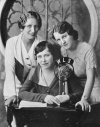
Here's an example. In the 1920s, Sears sold radios by mail, but there were large parts of America that didn't have any radio stations within range, so, Sears got into the radio station business and, in 1924, started WLS 890am Chicago. A radio station powerful enough to fill the Midwest.
Then, they sold every household in the Midwest and most of the rest of the country a radio. The kicker was that once they bought a radio, they tuned in to Sears radio station witch advertised Sears products.
The equivalent today would be if Walmart sold you the TV and then you only got Walmart commercials and ads on your TV.
Walmart was never that big.
WLS stood for World's Largest Store, and it was.
The only thing to ever come close would be Amazon Web Services providing you the internet so you can buy Amazon products and services.

richhodg66
Well-Known Member
oscarflytyer
Well-Known Member
"Sears got into the radio station business and, in 1924, started WLS 890am Chicago"
Had no idea. Used to hide under the covers at night as a kid and listen to baseball on WLS!
Had no idea. Used to hide under the covers at night as a kid and listen to baseball on WLS!
RicinYakima
High Steppes of Eastern Washington
When the sun went down, we could get WLS all the way to KY. Amazing what you could do the 500,000 watts kicking it out. In the 1970's WLW in Cincinnati still had their 500,000 watt gear for CONARAD and emergencies.
On good nights, we could get WLS in Fort Worth, Texas after sundown. Almost a touch of home for an Illinois farm boy.When the sun went down, we could get WLS all the way to KY. Amazing what you could do the 500,000 watts kicking it out. In the 1970's WLW in Cincinnati still had their 500,000 watt gear for CONARAD and emergencies.
We could also get the Grand Old Opry from WSM in Nashville which was far more preferred in 1965. The good rock and roll was fast disappearing.
JWinAZ
Active Member
Pulling in far away radio stations on a clear winter night was a very nice thing to do. The call letters of early stations often were initials of some kind. WSM was for "We Shield Millions", the slogan for a Nashville insurance company. The Border Blaster stations were interesting. I listened to AM radio a lot growing up. Seems that it is fading away now (pun intended, but in a sad way).
fiver
Well-Known Member
chuckle,,, i remember a few nights spent tweaking the dial a little this way then that trying to pick up something i got a skip of for a minute or so.
then moving on when it didn't come in anymore.
course living at the base of an 8-K foot hill, and using a 3 dollar transistor set didn't help things any.
then moving on when it didn't come in anymore.
course living at the base of an 8-K foot hill, and using a 3 dollar transistor set didn't help things any.
Mitty38
Well-Known Member
Used to have a radio shack short wave. Took it camping. When a kid, on top of the hill. A radio station out of Canada used to play the old Alfred Hitchcock hour. Took about 10 min to get the thing positioned right and tuned in.chuckle,,, i remember a few nights spent tweaking the dial a little this way then that trying to pick up something i got a skip of for a minute or so.
then moving on when it didn't come in anymore.
course living at the base of an 8-K foot hill, and using a 3 dollar transistor set didn't help things any.
A lot of good memories there.

